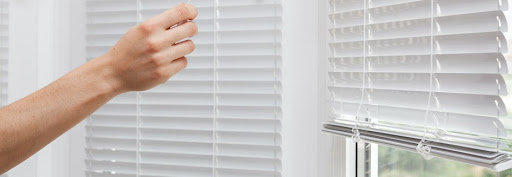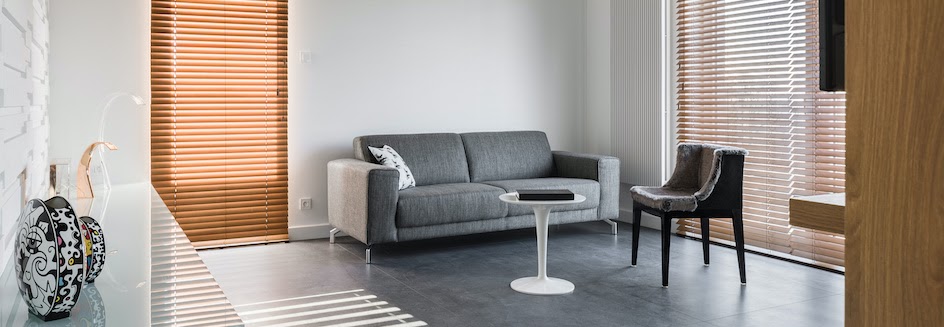Flip through any home decor magazine and you'll see a lot of white. And it's there for a reason. White is a blank canvas that allows other items — your mid mod home furnishings, that Asian-inspired painting you found at the car boot sale, and that hand-woven tapestry throw pillow, for instance — to become the star of the show.
True, there are some white trends we're happy to see fade away. (We're looking at you white couches. Seriously, have furniture designers never heard of kids and pets?) But, there are also places where white will always be welcome: walls, doors, crown moulding, and yes, window blinds.
When it comes to white window treatments, white venetian blinds are a timeless choice. But before you buy, consider these tips to ensure they're the perfect blind for you.
The Basics of Venetian Blinds
Venetian blinds are also called horizontal blinds because they're made from a series of horizontal slats that hang from a headrail via a cord or decorative tapes. You can angle the slats up or down by pulling on the tilt cord, or you can open the blinds by pulling on the raising cord. When you raise your venetians, the slats will stack up flat against the headrail at the top of the window.
Venetians can be made up to 260cm wide. Any wider and the slats may start to bow in the center. These blinds can have a drop of up to 300cm, making them ideal for tall windows.
If you have a window wider than 260cm, you'll need to order multiple sets of venetians and install them side-by-side to cover the full width of the window. If you love the look of white venetian blinds, this compromise may be worth it, but it does come with disadvantages. Light can creep in between the gap where the two sets of blinds meet, and you'll have to open the two sets separately every time you want to raise your window blinds.
How White Venetian Blinds Compare To Other Blinds
There are lots of blinds to choose from — roller blinds, vertical blinds, roman blinds — and they all come in white. So why choose white venetian blinds over any other type of blind?
Light Control
Venetian blinds offer the best light control of any window treatment. You can angle the slats to direct the light wherever you choose. Angle them up to keep light filtering into the room but out of your eyes, or angle them down to cast natural light onto your kitchen counters or work surface.
However, one of the major disadvantages of white venetian is their light blocking. Venetians can block up to 95% of the light, but they can't offer total darkness. If you prefer more room darkening, look for a blind with a blackout lining. (Roller blinds, vertical blinds, and roman blinds are all available with this feature.)
If you're someone who can't sleep with even a sliver of light creeping in, then you should choose blackout blinds over white venetian blinds for the bedroom. But if you're someone who prefers to wake up with a little natural light filtering in through the windows, choose white venetians over blackout blinds.
Style
White venetian blinds are a smart home decor choice. White reflects light, so it will help your space feel lighter and brighter. Venetian blinds have also stood the test of time — they've been a popular window covering for centuries. And choosing a neutral colour ensures that you won't have to change your window blinds every time you change your decor.
Plantation blinds or plantation shutters provide a similar look to white venetians, but these open out into the room (like a door), which means you'll need to keep your home furnishings clear of your windows.
Practical Considerations
White venetians are practical in most ways — they're durable, timeless, and easy to install. But there are a few practical reasons to choose a different blind.
If you have wide windows or windows that open sideways (instead of up and down), vertical blinds will be easier to fit and to open and close once they're installed.
And if your home has older windows made with fewer panes, a roman shade can help keep your home warmer in the winter and may even save you money on your electric bill.
Types of White Venetian Blinds
Ok, you've assessed your lifestyle (who knew shopping for window blinds required this level of introspection?), and you've decided that white venetians are definitely right for you. The next step is choosing your material.
White venetian blinds are available in three materials: aluminium, wood, and faux wood.
Aluminium Venetian Blinds
Aluminium venetian blinds are the most economical choice. They feature thinner, 25mm slats, which will let more light in than the wider 50mm slats you'll find on wooden blinds and faux wooden blinds. However, aluminium is resistant to rust and warping, making it ideal for a conservatory where the midday heat could warp real or faux wood.
Real Wood Venetian Blinds
Wooden venetian blinds offer a timeless, natural look. White wooden blinds are painted to match your colour preference, and they generally come with a matching valance to cover the headrail.
Real wood blinds offer the beauty of a natural wood grain, but they can be harder to care for than aluminium or faux wood blinds.
Real wood needs to be cleaned with a wood cleaner, and it can warp if it's in an area with high humidity like a kitchen or bathroom. Instead, choose real wood for the living room and dining room where it will be easier to maintain.
Faux Wood Venetian Blinds
White faux wood blinds are made from vinyl or PVC. High-quality faux wood blinds give you the look of real wood, but they're more waterproof, making them better for kitchens and bathrooms.
Will White Venetian Blinds Match Your Space?
We know: At the start we said that white is a blank canvas that matches everything. Well, that's mostly true. White matches everything except for very slightly different shades of white.
Spend five minutes browsing paint swatches at a B&Q, and you'll realize there are thousands of shades of white. If your home decor already features shades of off white, eggshell or morning mist, then you won't want to order your blinds in pure white. Conversely, if your walls are pure white, a set of eggshell blinds will look aged in comparison. The difference will be just obvious enough to irk you.
To avoid mismatched shades of white order free samples so you can compare the hue to the other colours in your space.





